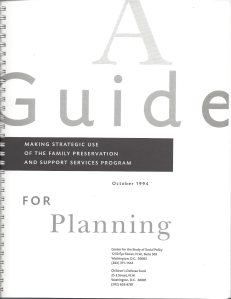 As part of the 40th anniversary celebration of IFPS, we are looking at federal involvement in family preservation. Advocates of IFPS were instrumental in helping to pass the first federal law on this issue, the Family Preservation and Support Services Program, enacted in 1993.
As part of the 40th anniversary celebration of IFPS, we are looking at federal involvement in family preservation. Advocates of IFPS were instrumental in helping to pass the first federal law on this issue, the Family Preservation and Support Services Program, enacted in 1993.
Information for this post is taken from the publication Making Strategic Use of the Family Preservation and Support Services Program: A Guide for Planning. The Guide, developed by the Center for the Study of Social Policy and the Children’s Defense Fund, was published in 1994 with readers encouraged to reproduce and disseminate it. The following are some of the highlights from the Guide:
The goals of the Family Preservation and Support Services Program are to:
- Protect children’s safety.
- Strengthen families’ ability to promote their children’s healthy
development. - Contribute to the development of a more responsive, collaborative, family-centered child and family service system.
The program authorizes resources for states to meet these goals
through broad-based and extended planning and through the strategic expansion of family preservation and family support services. Approximately $900 million will be distributed to states over the course of five years (FY 1994 through FY 1998) for planning and program expansion.
The legislation recognizes that family preservation and family support are not “stand-alone” services; they are part of a larger child and family service system. They stress that planning and implementation should not be limited to expansion of family preservation and family support services, but should seek to apply the principles underlying these services—family-centered, collaborative, and community–based service delivery—to all child and family services. Family preservation and family support services should be expanded in ways that encourage, facilitate, and leverage improvements in all child-serving systems.
Here’s how the legislation described family preservation services:
- Often offered to families as an alternative to their children’s placement in out-of-home care.
- Designed to maintain children safely in their homes and prevent the unnecessary separation of families.
- Characterized by small caseloads for workers, short duration of services, 24-hour-a-day availability of staff, and the provision of services primarily in the home or in another environment familiar to the family.
The federal government intended that the family preservation and support legislation would serve as a catalyst for improving service delivery. States were required to develop plans with five critical steps:
- Determining in detail the needs of children and families as well as state and local capacity to respond to these needs.
- Envisioning a more effective service system—one that responds earlier, more comprehensively and with greater flexibility—with the aim of strengthening families and promoting healthy child development.
- Developing policy and programmatic strategies that will enable states and communities to build this more effective system.
- Identifying all of the resources—federal, state, and local, public and private—available for child and family services.
- Determining how best to allocate (or reallocate) those resources so that they support state and local reform agendas.
_______________
Posted by Priscilla Martens, Executive Director, National Family Preservation Network
